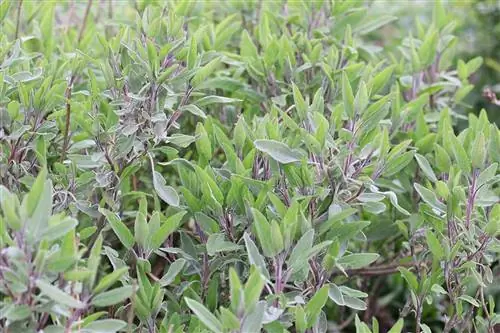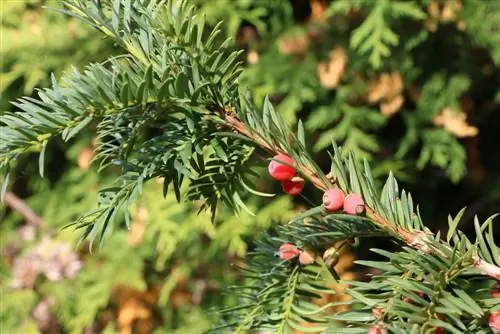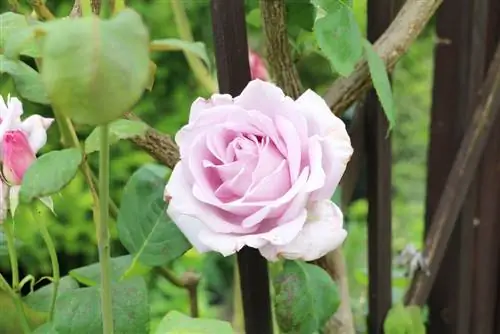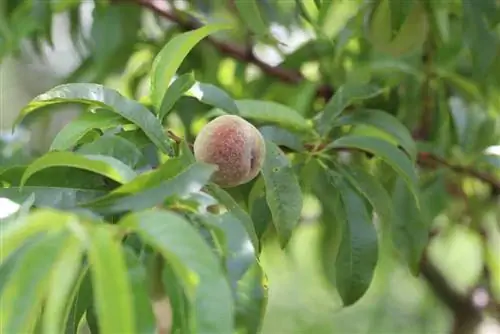- Author admin [email protected].
- Public 2023-12-17 03:39.
- Last modified 2025-01-24 12:45.
The tree peony, also known as the tree peony or botanically “Paeonia Suffruticosa”, belongs to the peony family and is a strongly fragrant plant that usually produces particularly large flowers up to 25 centimeters wide. The flowering period is between April and June, depending on the species and variety. The flowers are round and bright yellow, white, purple, red or pink. Some of them have a very pleasant smell, although this is not always the case. If you want to have particularly beautiful and large flowers, you should simply remove a few buds before flowering.
In general, the growth of tree peonies is very slow. However, the plant becomes very sprawling and can reach widths of between 80 and 150 centimeters. A shrub can grow just as tall. The tree peony can live to be more than 30 years old. There are even some plants that are more than 100 years old. The older the tree peony gets, the more impressive its growth is. It is also popular as a long-lasting cut flower.
Tree peony care
The care required for this plant is very low because it prefers to be left alone. The tree peony prefers a full sun or slightly partially shaded location. It thrives best in humus-rich, nutrient-rich, calcareous and moist soil. However, waterlogging must be avoided in any case. The best location is in a protected location that is not at risk of late frost, for example near a wall or house wall.
You must also pay attention to regular watering because the tree peony must not dry out. With regard to fertilization, it can be said that adding a slow-release fertilizer in the spring is usually completely sufficient. Alternatively, you can fertilize sparingly every month. In order to prevent diseases, it is always important that the dead leaves are removed. Furthermore, care must be taken to ensure that if you do not want to collect seeds, the seed capsules should be removed. The plant has to use a lot of energy to mature, which it would be better to put into flowering.
In spring, the tree peony is thinned out. To achieve rejuvenation, this plant can also tolerate more pruning. The tree peony is a hardy plant, which should still be protected outdoors with leaves or a fleece. It is important to provide good winter protection, especially in the first year after planting.
Propagation and planting of the tree peony
The best way to propagate the tree peony is through grafting. Sowing, however, is not always successful. While with the grafting variant it usually takes two to three years until the first flowers appear, with sowing it takes much longer.
The best time to plant is in spring or autumn when the ground is warm. Basically, tree peonies have to be planted deeper into the ground than perennial peonies. At least ten centimeters underground is the rule of thumb. This is the only way to prevent the scion from sprouting from the sleeping eyes and to achieve a densely bushy growth.
Tree peony as a remedy
The root bark is often used in natural medicine because of its ingredients. It is said to have an antispasmodic and calming effect. In East Asia, its use in alternative medicine is very widespread, which is why there are large fields in these regions where the tree peony is grown.
In this context, it is important to know that these preparations must not be taken during pregnancy. This is because all parts of tree peonies are also slightly poisonous. Consumption may cause nausea.
What kind of plant is the tree peony?
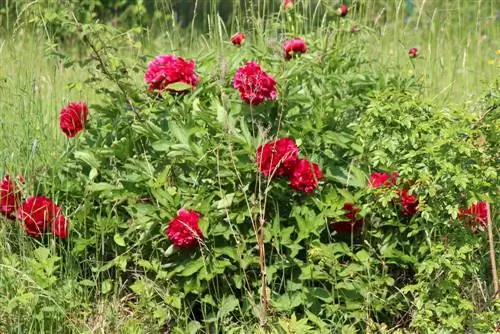
The peonies come from the peony family from the order Saxifrages, a very diverse order that also includes currants and witch hazel (witch hazel). The peony or peony forms its own genus with more than 30 species, most of which come from Eurasia. The tree peonies form a separate plant species within the peonies, which do not absorb the above-ground parts of the plant in autumn. These plants grow like bushes and become woody; they can reach a huge height of over 2 meters, which is why they are also called tree peonies. They come from China, where the wild form lives in the high mountains and is correspondingly resilient.
How do you get a young plant?
- In principle, peonies can be grown from seeds, but the long germination period (one to three years depending on the species) makes most hobby gardeners reluctant to do this. That's why the tree peonies are usually propagated by nurse grafting on the roots of perennial peonies and offered as young plants.
- When you buy the plants, look for specimens with the largest possible root ball or well-rooted potted plants. Imports are often offered “bare root”; due to import regulations, the soil and fine roots have been completely removed. This poses problems for the plant; it can only form new fine roots in early autumn. So if it has to be bare-rooted, the planting should definitely be done by the end of September. For plants brought in later, you have to take some losses into account, which will only become visible next summer. Until then, nutrients can be drawn from the main root, but only the fine roots enable the peony to build up new nutrient reserves that it can fall back on in the summer.
Planting a tree peony
- For your tree peonies, you should choose a location where waterlogging can be avoided; they are more likely to tolerate a dry period if they are well rooted. Any sunny to partially shaded location with normal soil is suitable; peonies with large root balls usually grow well even in dry and poor soil.
- Depending on the root status, you can plant from the end of August to mid-October, very late only if the fine roots are well developed. On planting day it should be humid and not very sunny outside. When planting, the uppermost root parts are only covered with 3 to 4 cm of soil. In the case of grafted peonies, the grafting area must also be brought underground, otherwise the plant cannot form its own roots there
- You can promote growth if you enrich the soil with ripe humus, then fertilize to make growth easier. Horn shavings or natural lime powder are suitable; once the tree peony has grown, it is frugal. It is even grateful for poor soil without fertilizer, so it can root deeply. However, you should give the new plantings winter protection in the first year that protects the root area from severe frost (covering with soil or mulch).
Caring for shrub peonies
- The tree peony will sprout very early next year, in warmer regions from February onwards, in colder regions a little later. At first the shoots are very soft and sensitive, but when the peony starts to bloom this is over and it now has flexible and unbreakable branches. Care for the robust plants is essentially limited to occasional watering and year-round observation so that signs of disease are detected in good time.
- Sometimes fungi appear on the young shoots, then the acidity of the soil is usually too high and an application of lime counteracts this. The fungus-infected shoots are generously removed and disposed of away from the garden (do not compost). But this rarely happens, otherwise there is not much to worry about: neither harmful insects nor snails or voles like the poisonous peonies.
- The tree peonies tend to be reluctant when the garden soil is too moist, which is where installing a drainage system helps. If you foresee that there will be too much moisture, you can plant the peonies elevated on mounds of soil.
- If the tree peony feels comfortable, it will bloom from around mid-April to the end of May, depending on the variety and the weather, from countless flower buds and then produce a decorative autumn color. You can then just enjoy it, you don't even have to remove the dead inflorescences: they usually form very decorative fruit clusters that can be made into dry bouquets and arrangements in September. You can also harvest seeds from the fruit heads for propagation. The practical plant also prevents you from meticulously chopping weeds, as you could injure the roots.
- If the peony is only a few years old, it is usually so deeply rooted in the garden soil that it no longer needs to be looked after at all, not even watered, even in dry summers. Only in extremely dry areas can you give your tree peonies some water in early autumn, which promotes new root formation. Large plants crowd out any weeds so much that there is hardly any work left.
Cutting peonies
- When the dormant phase begins above ground in early autumn, the peonies are pruned. If you always cut directly above one eye, no ugly branch stumps will appear after the spring shoots. Above all, the autumn leaves are removed, which could serve as winter quarters for pathogens, but this does not have to be the case if the plants are absolutely he althy.
- Otherwise the cut is more for beauty. Generally it is still quite warm at this time, so the interfaces can dry well and close quickly. The use of a wound closure agent is only recommended if you are planning radical cutting measures.
- Such measures can, for example, be used to grow a standard tree from the shrub-like peony, which can develop a very considerable trunk diameter over the course of several years. You can even plant the tree peonies as a hedge, then they are trimmed to a specific shape like a hedge.
- The tree peonies of the “Paeonia rockii” variety are known to be particularly robust; a special feature is the “Paeonia intersectional”, this hybrid combines the positive properties of the tree peonies with those of the popular perennial peonies.


